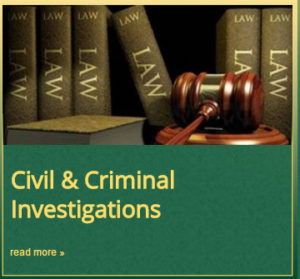Articles
Behind The Tinted Glass
To Each His Own
By Kelly L. Cahalan, SIU Director of Development
Anyone who has investigated a missing person case knows there’s a fine line when looking for a missing adult. There’s always the question of whether the adult wants to be found. Nothing is illegal about an adult leaving one life to go lead another. Yet until the person is found, how does anyone know the answer to the question? A missing adult case can be tricky for this reason alone. Nevertheless, for the loved ones left behind with unanswered questions, it is often a difficult balancing act of giving someone their space and searching for the missing person. Parents often say, even though children grow up and become adults, they are still your children.
“James,” a father who had daughter going to college in a different state, was concerned because his daughter, “Myra”, had stopped communicating with him and her mother. Maybe she was just too busy for her parents; after all she was a college student, had a vehicle her parents bought for her, and was free from the watchful eye of her parents.
After 3 months of not hearing from his daughter, James contacted the local Sherriff’s office to voice his concern. The Sherriff found Myra had actually dropped out of college. Myra’s whereabouts were unknown, which was complicated by the fact she was not using any credit or debit cards, making a trail difficult to find. Six months passed and still the family had no clue where Myra was, whether she was in trouble, or simply off to start a new life.
During the 6 months of no contact from Myra, James hired a Private Investigator to track down Myra, but to no avail.
However, James was not about to give up searching for his daughter. James hired another Private Investigator, Glenn Holmes of H&H Private Investigations located in Santa Fe, NM. Mr. Holmes listened to the situation presented by James and decided he indeed could do something to help James. Mr. Holmes has his client’s interest in mind and will not take on a case unless he thinks he can actually help the client. “I won’t take a client’s money if I don’t think I can help.” states Holmes.
After some intensive research on Myra, Mr. Holmes found Myra had sold the car given to her by her parents. From there, Holmes was able to track down the individual who purchased the vehicle and uncover a few clues from the purchaser: Myra was with a man who appeared to be a boyfriend and they were traveling in a unique looking vehicle with an unusual paint job. Sounds pretty easy, right? That is until its put into the context of trying to find such a vehicle in the state of New Mexico. Myra could be anywhere.
After a few interviews and some more research, Mr. Holmes was able to pinpoint Myra’s location to an Indian Reservation in NM. This could be a hurdle in and of itself since Indian Reservations are sovereign nations. That means not just anyone can gain access to the reservation and reservations have their own police and laws. Not to be deterred, Mr. Holmes put his nose to the ground and was able to find Myra’s exact location.
Now here comes the tricky part. Myra is an adult and has every right to simply disappear and begin a new life. James had no legal repercussions to the decisions Myra made. James flew to NM and met with Mr. Holmes to discuss the way ahead. James knew he had no legal recourse but he just wanted to know if his daughter was alive and well.
Holmes was able to gain access to Myra’s home on the Indian Reservation and determine she was indeed alive and well. Within 3 days of hiring Mr. Holmes, James, who had been carrying a heavy burden of not knowing what happened to his daughter, knew where his daughter was living. As it turns out, Myra had started using an alias, and was living with her boyfriend, the same man she was seen with when she sold her car. After further investigation it appeared Myra and her boyfriend had met while she was at college and decided to start a new life without her family’s involvement. There was nothing her mother or father could do, legally, to change the situation.
Myra never knew her family was looking for her, and never knew her father had hired a Private Investigator to find her, but her parents could at least rest easy knowing she was still in existence. It is often said, “To Each His Own” but it sure doesn’t make it easy for any parent or loved one left behind.
About the Author
Kelly L. Cahalan has extensive experience in not only private investigations, but also served 20 years in the U.S. Air Force. She earned her Master’s Degrees in Business Administration from Colorado Technical University with an emphasis in Project Management and also has a Bachelor of Science degree from the University of Maryland in Management and Behavioral and Social Science. For the past 22 years, Kelly has been recognized for her military work and volunteerism receiving distinctive awards from not only the U.S. Air Force, but from several local communities where she has served.
Special Investigative University
The Future of Private Investigation
At SIU, find the tools and resources needed to conduct professional investigations. If this sounds rewarding, exciting and interesting, please visit SPECIAL INVESTIGATIVE UNIVERSITY at www.SIUniv.com for additional information, or call 888-748-4005 to speak to an enrollment representative today.
The Same But Different!
By S. Kelly Cahalan and Glenn Holmes
Professional investigators are often called upon to assist in missing person cases. It could be because the family is not satisfied with the law enforcement work, or they feel the law enforcement have not made the case a top priority, or simply because the family wants a second set of eyes, so to speak, on the case. PIs play an essential role in such cases. The different categories of missing person cases will be compared, the different categories contrasted, and tips and tricks shared for the PI in this article.
Compare and Contrast
Missing person cases can be classified into three categories:
- Children
- Runaways/throwaways
- Adults.
Although the categories are all missing persons, there is significance in how each category is handled as compared and contrasted below.
Missing Children
A missing child case is taken very seriously by law enforcement and the public. Over the years we have all heard of the Adam Walsh and Amber Hagerman cases. Each ended in absolute tragedy, but some good things did result from both, which increased law enforcement’s ability to recover future missing children.
The Adam Walsh Child Protection and Safety Act established a national database of convicted child molesters, increased penalties for sexual and violent offenses, and commands law enforcement agencies to inform federal law enforcement within two hours of receiving a missing child complaint. All missing children records are now held in the National Crime Information Center. (1)
The AMBER Alert™ Program, named after Amber Hagerman, is a voluntary partnership between law enforcement agencies, news broadcasters, transportation agencies, and the wireless industry, to activate an urgent bulletin in the most serious child abduction cases. The goal of an AMBER Alert is to instantly galvanize the entire community to assist in the search for, and the safe recovery of, the child, if possible, and to notify the community of the missing child, where and when they were last seen, description of the child, and what they were last seen wearing. The public awareness of missing children has contributed to saving the lives of 502 children. (2)
Missing children- Runaways/Throwaways
Contrast a missing child case with a runaway/throwaway case and one will find the sense of urgency is not quite as apparent in comparison. Runaways, (juveniles who runaway voluntarily) and Throwaways, (juveniles who are forced out by a parent/guardian,) can be multifaceted cases. The u.s. Department of Justice estimates that each year, as many as 450,700 missing children are considered to be runaways. (3) Although these juveniles are still legally children, the law enforcement priority lowers not because there is less importance to the child’s safety but because juveniles often run away again shortly after law enforcement returns them home.
PIs make a difference in these cases because their priority is different from law enforcement’s. In many cases, the runaway’s friends and/or family are hiding the person. The PI can ascertain this by doing interviews. However, even though it’s a lower priority for law enforcement, a missing runaway/throwaway case is quite important because some of these children are not actually in protected homes, but are instead on the street and susceptible to the bowels of society. Adding to the complexity of the case is that there are normally reasons why the juvenile left the home. Returning the juvenile back home is not always in the best interest of the child. So the PI plays an integral role in not only finding the child, but in figuring out if the child is safe or in harm’s way. It’s not a matter of simply finding the juvenile, but may require involving other family services such as child welfare protection.
Missing Adults
Now, contrast this even further to a missing adult case. Since there is no federal law that governs reporting missing adults, and it is not illegal for an adult to simply disappear, these cases tend to have a complexity in and of themselves, especially if there is no evidence of foul play.
Without such evidence, adult missing person cases are one of the lowest priorities for law enforcement. Again, not because the health of the missing adult is not important, but because law enforcement must prioritize cases and if there is no evidence of a crime, there is not much they can do. Many families turn to PIs for this very reason. The family’s priority is to determine what happened to their loved one. Since missing adult cases are unique, here are some tips and tricks:
- The interview process is the foundation of the investigation. The PI must not rely on law enforcement reports alone, but should hit the streets and start interviewing people. One interview normally leads to more.
- Start with the basics: Who was the last to see this person? Who is associated with this person? What was the attitude of the person (happy, depressed, looking forward to anything, did the person mention any plans, did the person sell anything recently?)
- Dig a bit deeper: Is this person a drinker? Any drug use? Does the person have good computer skills? Sexual orientation? Ever been homeless? Does the person tend to mooch off others? Is the individual facing financial trouble? All these questions can put you on the right path.
- Real investigative work means talking to people, often face to face. Telephone conversations are good, but the PI is unable to read the person’s body language that may tell a whole different story.
- Do not rely only on public records, as we all know public records are not 100% accurate. Family and friends can tell you more than most any public record search. This leads back to the interview. A public search will not tell you who this person hangs out with or who he is dating, but the interview most likely will.
- Analyze and follow through on any clue, even the tiniest of clues. It’s often the smallest piece of information that leads to something big.
- Do not profile just the missing adult; profile family, friends, and acquaintances.
- Capitalize on the media. Keep in mind the media may not be aware of a missing adult case, so take the story to the media.
- Surveillance is a covert way to follow through on solid leads. For example, if the person is a drinker and has a favorite bar, survey the bar. If the person likes a certain band, get the band’s schedule and survey the event.
- Exploit the Internet. For example, search www.allcraigs.com to see if the person is selling anything or looking for a place to stay. Social media channels are often a wealth of information. Take into account you want to look for the person, but you also need to look at the activities of friends, family, acquaintances. Are any of them selling something that belongs to the missing adult? Are they posting anything on social media outlets that will help your case?
What happens if you find the missing adult:
That depends on the person who was missing— assuming a crime isn’t involved. Remember, there is nothing illegal about an adult starting a new life and leaving all behind. One way to handle the situation is for the investigator to talk to the missing adult and ask if she wants contact with those trying to find her. The answer will be all you need to know.
Another way to handle the situation is to let those trying to find the missing person know the individual has been located and is alive and well. Sometimes people just need to know their loved one has not encountered foul play. If the individual didn’t want to be found, the individual is alive and well, and no foul play is detected, there is not much anyone can do.
For more information, visit the National Center for Missing & Exploited Children at www.missingkids.com, and the National Center for Missing Adults (a “Let’s Bring Them Home” program) at www.theyaremissed.org.
Endnotes:
(1) http.//www.missingkids.com/en_US/documents/AdamWalsAct.pdf
For more information, visit the National Center for Missing & Exploited Children at www.missingkids.com, and the National Center for Missing Adults (a “Let’s Bring Them Home” program) at www.theyaremissed.org.
Endnotes:
(1) http.//www.missingkids.com/en_US/documents/AdamWalsAct.pdf
(2) http://www.missingkids.com/missingkids/servlet/PageServlet?LanguageCountry=en_US&PageId=991
(3) Yates, G.,J. Pennbridge, A.Swofford and R.MacKenzie (1991). “The Los Angeles System of Care for Runaway/Homeless Youth.” Journal of Adolescent Health 12:555-560.
Kelly L Cahalan (kcahalan@siuniv.com) is the Director of Development for Special Investigative University (www.siunivcom) in Colorado Springs, CO.This article reprinted with permission from PI Magazine. www.pimagazine.com






